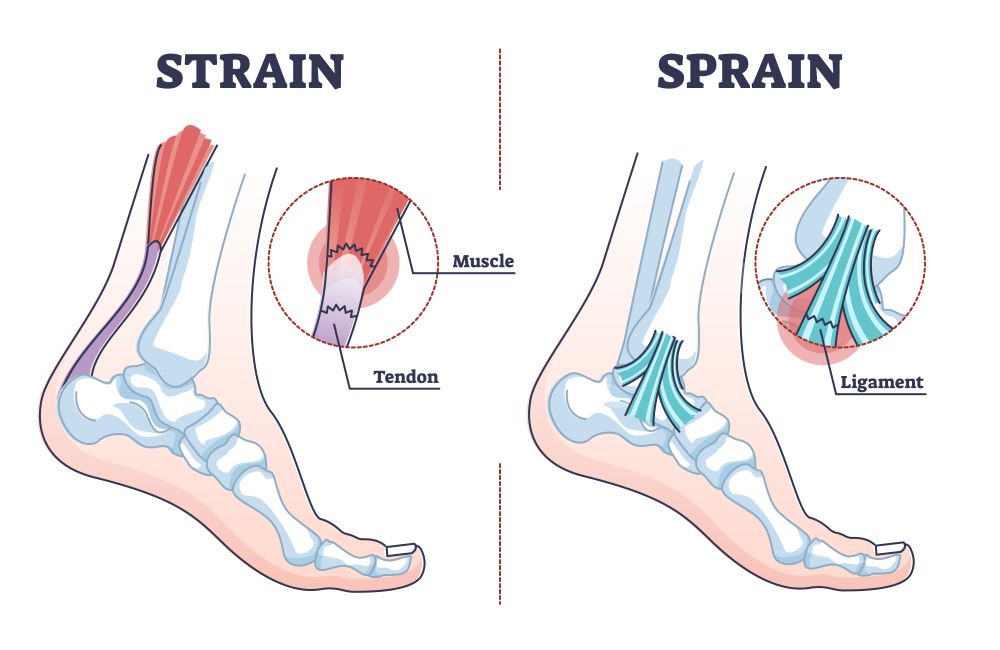
Not all injuries are complicated, serious, or uncommon, and most of us have likely managed to get a variety of sprains and strains during our daily lives. However, while they might be painful, after a few days of rest and healing, the swelling and pain recedes, and a couple of weeks after that, everything is completely back to normal – not so serious, right?
Sprains and strains are often obtained from physical activities and sports, but can also originate from overuse, awkward movements or positions, and improper lifting. Make sure you consider the risk factors for certain activities as well, as uneven ground, slippery conditions, failing to warm up and cool down after workouts can heighten your risk.
Depending on the type and severity of pain that you experience with the injury, it’s important to know which is which and how risky it can be to overuse an injured joint or muscle. Simply put, while they are both acute, soft-tissue injuries, a sprain is an injury to a joint or the connective ligaments and a strain is an injury to muscles or tendons.
Sprains
Sprains happen when the joint capsule or surrounding ligaments of a joint are stretched or torn. A joint capsule is a dense, fibrous connective tissue that is attached to the bones in a joint that seals the joint space, and a ligament is a stronger band of connective tissue that connects the end of one bone with another to stabilize and support the body’s joints. All joints are susceptible to sprains, but the most vulnerable are the ankles, knees, thumbs, and wrists.
The symptoms of sprains will vary with severity, but may include pain, swelling, stiffness, and reduced stability and function. Regarding severity, there are 3 grades of sprains that your injury can fall into:
- Grade 1 (Mild): There is slight damage to the fibers of the ligament that can cause pain and mild swelling, but mobility and function are mostly unaffected.
- Grade 2 (Moderate): There is partial tearing of the ligament, which causes abnormal looseness in the joint when it is moved in certain ways and decreases mobility.
- Grade 3 (Severe): There is a complete tear of the ligament, which causes significant instability and loss of function.
Strains
A strain is similar to a sprain, except that with strains, the muscles and tendons are majorly affected rather than ligaments. They are caused by a sudden stretching or tear of your muscles or your tendons, which are heavy bands of fibrous tissue that connect your bones to your muscles and allows movement. This function is what sets them apart from ligaments, which are there only for bone-to-bone connective purposes. The most common muscles affected by strains are the hamstrings, the back, and the gastrocnemius muscle in the calf.
Symptoms of a strain may include pain, muscle spasms, muscle weakness, swelling, inflammation, and cramping.
Treating Sprains and Strains
Usually, sprains and strains will heal by themselves with enough care and time off. Be careful not to overuse an injured joint or muscle, or you risk re-injury or worsening of the injury. Instead, the R.I.C.E. method is recommended: Rest, Ice, Compression, Elevation. If you have a severe grade 3 sprain or strain, then you may be directed towards an orthopedic specialist or physical therapist to assist in the healing process.
If you or someone you love has suffered a sprain or strain injury in the Louisville, Kentucky-area, board certified sports medicine physician Dr. Stacie Grossfeld at Orthopaedic Specialists PLLC can help. Orthopaedic Specialists PLLC is accepting new patients, and same day appointments are available. For additional information or to schedule an appointment, please contact Orthopaedic Specialists PLLC today at 502-212-2663.

Recent Comments